It is not a one function question.
There are more compact answers, but it is clearer step by step.
First the data:
month_year <- c(
"08-2021",
"09-2021",
"10-2021",
"11-2021",
"12-2021"
)
monthly_values_var1 <- c(
598,
532,
736,
956,
780
)
monthly_values_var2 <- c(
18.3179,
62.6415,
11.1033,
30.7443,
74.2076
)
df <- data.frame(month_year, monthly_values_var1, monthly_values_var2)
df
Some useful libraries:
library(dplyr)
library(lubridate)
library(stringr)
It needs a similar data frame to save new data:
df$month_year <- lubridate::dmy(paste0('01-',df$month_year))
new.df <- df[0,]
Now the code
counter <- 1
for (i in 1:nrow(df)) {
days_month <- lubridate::days_in_month(df[i, 'month_year'])
mean1 <- df[i, 'monthly_values_var1']/days_month
mean2 <- df[i, 'monthly_values_var2']/days_month
for(j in 1:days_month){
if (j < 10) {
value <- str_pad(string = j, width = length(as.character(j))+1, pad = "0")
} else {
value <- as.character(j)
}
new.df[counter, 'month_year'] <- paste0(lubridate::year(df[i, 'month_year']),'-', lubridate::month(df[i, 'month_year']), '-', value)
new.df[counter, 'monthly_values_var1'] <- rnorm(n = 1, mean = mean1, sd = mean1/3)
new.df[counter, 'monthly_values_var2'] <- rnorm(n = 1, mean = mean2, sd = mean2/3)
counter <- counter + 1
}
}
View(new.df)
lubridate::days_in_month() function shows how many days are in a specific month.
rnorm assign a random number with normal distribution. I choose a mean around each data divided days in month, and a standard deviation mean/3.

